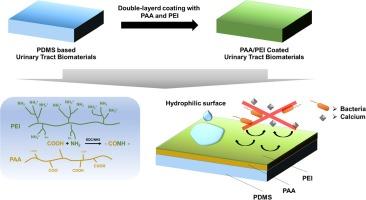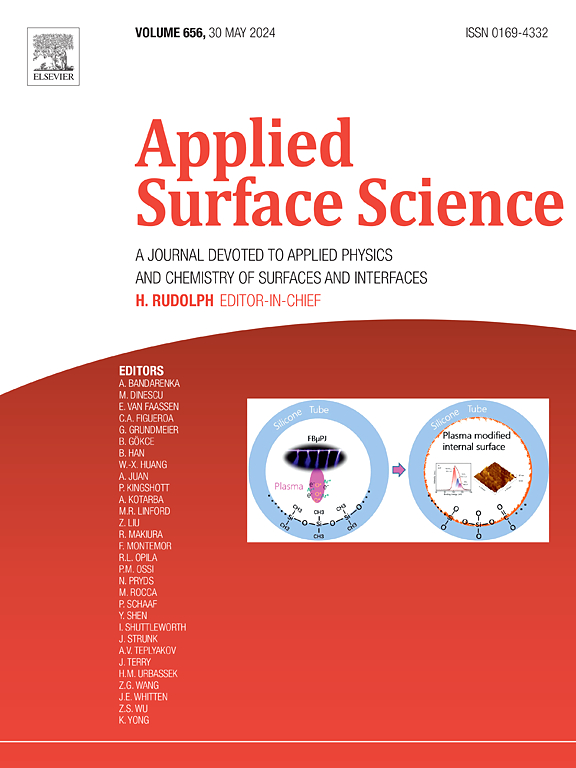Dual layer-coating of PDMS to prevent calcification and bacterial infection for the potential use of urinary tract biomaterials
IF 6.3
2区 材料科学
Q2 CHEMISTRY, PHYSICAL
引用次数: 0
Abstract
Polydimethylsiloxane (PDMS) is widely used in medical devices because of its exceptional properties. However, challenges, such as biofouling and bacterial infections, arise from their hydrophobic nature, especially in devices intended for the urinary tract. To address these issues, this study pioneered a surface modification strategy aimed at enriching PDMS with both hydrophilicity and antifouling attributes, making it ideal for urinary tract device applications. We introduced a novel dual-layer coating process, initially grafting a hydrogel-like poly(acrylic acid) (PAA) layer onto PDMS through benzophenone-mediated photoinitiated polymerization to enhance surface hydrophilicity. Subsequently, polyethyleneimine (PEI) was covalently bonded to the PAA layer, ensuring the formation of a stable antifouling surface that prevented bacterial adhesion and calcium deposition. This method guarantees a robust coating that performs consistently across various environmental conditions, including the fluctuating pH levels typical of the urinary tract. Comprehensive surface characterization validated the substantial improvements in hydrophilicity along with significant reductions in bacterial adhesion and calcium deposition. The innovative PAA/PEI dual-layer coating demonstrated marked superiority over conventional uncoated and single-layer-coated PDMS samples, offering a promising solution for enhancing the safety and efficacy of PDMS-based urinary tract devices. The implications of this study extend beyond immediate applications and provide valuable insights into the domains of biomaterials and medical device engineering.


防止钙化和细菌感染的 PDMS 双层涂层,可用于泌尿道生物材料
聚二甲基硅氧烷(PDMS)因其优异的性能被广泛应用于医疗设备中。然而,由于其疏水性,特别是在用于泌尿道的设备中,存在生物污垢和细菌感染等难题。为了解决这些问题,本研究开创了一种表面改性策略,旨在丰富 PDMS 的亲水性和防污特性,使其成为泌尿道设备应用的理想材料。我们采用了一种新颖的双层涂层工艺,首先通过二苯甲酮介导的光引发聚合作用在 PDMS 上接枝一层水凝胶状的聚丙烯酸(PAA)层,以增强其表面亲水性。随后,聚乙烯亚胺(PEI)与 PAA 层共价键合,确保形成稳定的防污表面,防止细菌附着和钙沉积。这种方法保证了涂层的坚固性,在各种环境条件下(包括典型的泌尿道 pH 值波动)都能保持稳定的性能。全面的表面表征验证了亲水性的大幅改善,以及细菌附着和钙沉积的显著减少。创新的 PAA/PEI 双层涂层明显优于传统的无涂层和单层涂层 PDMS 样品,为提高基于 PDMS 的尿路装置的安全性和有效性提供了一种前景广阔的解决方案。这项研究的意义不仅限于眼前的应用,还为生物材料和医疗设备工程领域提供了宝贵的见解。
本文章由计算机程序翻译,如有差异,请以英文原文为准。
求助全文
约1分钟内获得全文
求助全文
来源期刊

Applied Surface Science
工程技术-材料科学:膜
CiteScore
12.50
自引率
7.50%
发文量
3393
审稿时长
67 days
期刊介绍:
Applied Surface Science covers topics contributing to a better understanding of surfaces, interfaces, nanostructures and their applications. The journal is concerned with scientific research on the atomic and molecular level of material properties determined with specific surface analytical techniques and/or computational methods, as well as the processing of such structures.
 求助内容:
求助内容: 应助结果提醒方式:
应助结果提醒方式:


